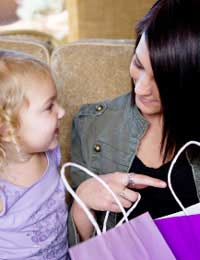Marketing to Children and Parents

Ordinarily, marketing fashion designs is fairly straightforward - you simply have to get the designs people want to wear into places where they can see them. But because it requires promoting your work to a duel audience, marketing children's clothes can be rather more complicated. You have to make the clothes attractive to the people who'll be wearing them at the same time as convincing the actual buyers - their parents - that they're a sensible purchase.
Competing Priorities
In order to market clothes successfully to both children and their parents, you need to understand their different priorities and the degree to which each party is usually willing to compromise to satisfy the other. Many shops make elementary mistakes in this regard - for instance, 'back to school' sections may attract parents, but older children will always want to avoid them. Clothes that are practical for school can be presented alongside images of stylish looking kids to far greater effect.Younger children are inevitably attracted to bright colours, frills and shiny things, whilst their parents need to buy them things that are more practical. A few child-friendly items placed in prominent positions alongside practical items can attract children and keep them occupied whilst their parents make sensible choices. If you're lucky, they'll then pester their parents into buying the fancy clothes too.
Pester Power
If you've seen children demanding sweets beside supermarket check-outs, or if you've been caught up in the crazed Christmas rush for a must-have toy, you'll know something about pester power. This is the process whereby goods are carefully targeted at children so that they, in turn, will nag adults to buy them. The adults don't need to be particularly impressed by the items - eventually they'll give in just to keep the children quiet.When you're a small business you're unlikely to be able to publicise anything highly enough to make children see it as a must-have item. However you may still find pester power useful, especially with smaller, lower cost items. Accessories kept near your tills can sell well on this basis, and offering small free toys with larger purchases - toys kept where children can see them - can increase you chances of making a sale.
Child-Friendly and Parent-Friendly Shopping
The actual process of shopping is a nightmare for many parents, especially if they have several children to deal with. Making this easier for them can quickly make your shop one of their favourites.Simple things you can do include providing a couch for tired parents to sit down on whilst their kids explore, providing toys to amuse smaller children, and making sure that your staff are always ready to help when somebody is struggling to get through the door with a pushchair.
Successful marketing to young children can mean re-arranging your premises so that the clothes they're interested in are easy for them to examine. Children like places that pay attention to their needs and make them feel included. Child-scale furniture can be particularly appealing to them. However, you'll need to pay careful attention to make sure they don't pull items onto the floor and damage your displays.
Older Children
As children get older and begin to resent shopping with their parents, clothing designs and promotion should reflect their need to assert their independence. Older children don't like having choices made for them, so marketing materials should be addressed to them.Celebrity-related promotions are particularly effective in this sector as children are highly celebrity aware, though you'll have to stay on your toes to keep up with who they respect and who is yesterday's news.
Parents have two major concerns when it comes to older children's clothes: that boys will dress to align themselves with anti-social gangs, and that girls will express too much precocious sexuality. It can be difficult to balance these concerns with what your young customers want, so try to have staff on hand at the point of sale to address parents whom you think are unnecessarily concerned, for instance by explaining just how ordinary designs like yours are for that age group.
There's a point at which adults and children will never agree, and that's when children start going shopping on their own. In the meantime, it's your job to be diplomatic and keep both sides happy if you want to make successful sales.
Business Energy With a Difference
If you are looking for business energy or need advanced solutions like remote energy monitoring, new supplies, downgrading or upgrading capacity, have a no obligation chat with Purely Energy.
To find our more get in touch here. or call 0161 521 3400.








